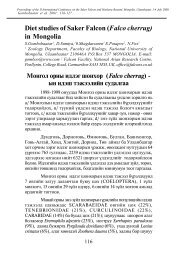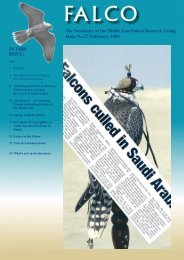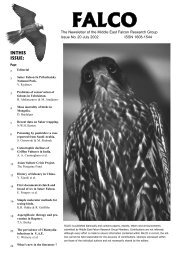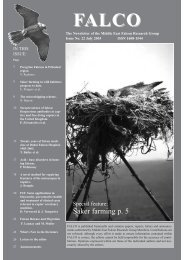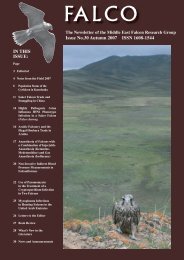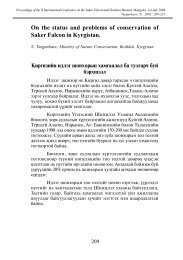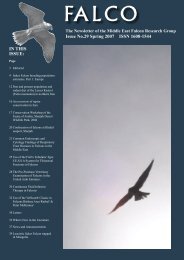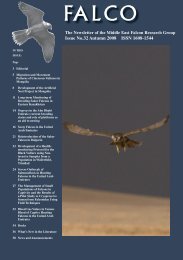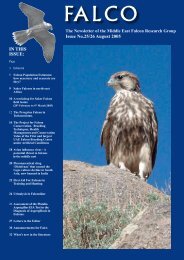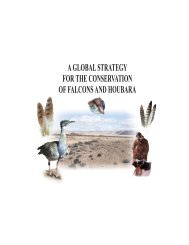Saker Falcon projects - International Wildlife Consultants Ltd.
Saker Falcon projects - International Wildlife Consultants Ltd.
Saker Falcon projects - International Wildlife Consultants Ltd.
You also want an ePaper? Increase the reach of your titles
YUMPU automatically turns print PDFs into web optimized ePapers that Google loves.
<strong>Saker</strong> <strong>Falcon</strong> (Falco cherrug) breeding population in the Eastern Junggar Basin of<br />
Northwestern China<br />
Staff: Dr. Andrew Dixon, Prof. Ma Ming, Dimitar Ragyov<br />
Participating organisations: IWC; Xinjiang Institute of Ecology and Geography,<br />
Chinese Academy of Sciences; Institute of Biodiversity and Ecosystem Research,<br />
Bulgarian Academy of Sciences<br />
Period of project: 2005-06<br />
Status: Data still to be analysed. Results of two seasons survey work in the eastern<br />
Junggar Basin, providing information on breeding density, nest site tenacity, nesting<br />
dispersion (in relation to nest site availability and other raptors), breeding success.<br />
The importance of the Qinghai-Tibetan Plateau ecoregion for the globally<br />
Threatened <strong>Saker</strong> <strong>Falcon</strong> (Falco cherrug)<br />
Staff: Dr. Andrew Dixon, Prof. Ma Ming<br />
Participating organisations: IWC; Xinjiang Institute of Ecology and Geography<br />
Period of project: 2007-08<br />
Status: Data still to be analysed. Results of two seasons survey work on the breeding<br />
and wintering population of <strong>Saker</strong> <strong>Falcon</strong>s on the Qinghai Tibetan Plateau, together<br />
with an analysis of their winter ranging behaviour derived from satellite telemetry,<br />
and an assessment of current threats posed by rodent poisoning, electrocution,<br />
habitat change and falcon trapping.<br />
Future developments<br />
In 2012 we shall re-establish links with our partner organisations in Qinghai<br />
in order to establish a project to (i) trial the use of artificial nests to increase<br />
predation rates on Plateau Pikas in order to reduce the need for expensive and<br />
ecologically damaging poisoning campaigns and (ii) trial the use of various<br />
mitigation measures on electricity distributions lines to reduce raptor electrocution<br />
rates and to increase awareness of the issue among Chinese electrical engineers.



